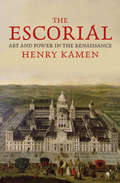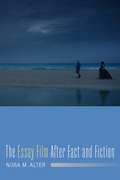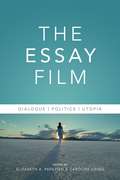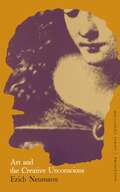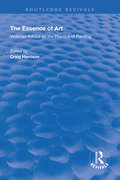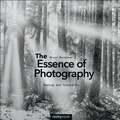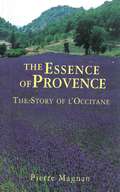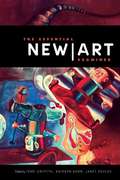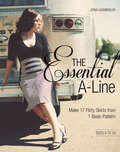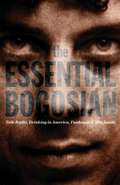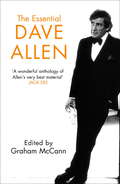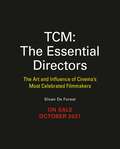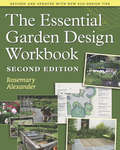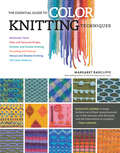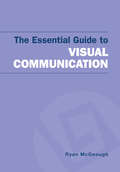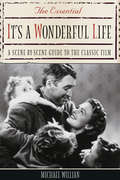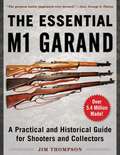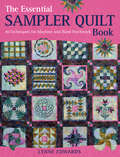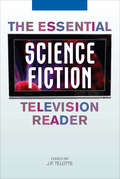- Table View
- List View
The Escape from Elba: The Fall & Flight of Napoleon, 1814–1815
by Norman MacKenzieThe year is 1814. The Allies have driven Napoleon's once-mighty armies back to Paris. Trapped, forced to abdicate after two decades of triumphant rule, the Emperor takes leave of his comrades-in-arms and sets sail for his new domain - the tiny, poverty-stricken, pestilential island of Elba. Yet within ten months Napoleon will enter Paris once again, at the heels of the fleeing Bourbon king, flushed with victory and cheered by the masses. The Escape From Elba tells the heroic story of Napoleon's exile and phoenix-like return. In this classic account, now republished in paperback, Norman MacKenzie chronicles this extraordinary year: the tense last hours of Napoleon's empire, his humiliating exile, his midnight escape and his whirlwind march over snowbound mountains to Grenoble where, in a dramatic confrontation with the French army, he became a reigning prince again. Described in vivid detail are Napoleon's adventures as the head of Elba. He brought society, splendour, organization and political intrigue to this run-down backwater. And he displayed on this small stage the many sides of his charismatic.
The Escorial
by Henry KamenFew buildings have played so central a role in Spain's history as the monastery-palace of San Lorenzo del Escorial. Colossal in size and imposing--even forbidding--in appearance, the Escorial has invited and defied description for four centuries. Part palace, part monastery, part mausoleum, it has also served as a shrine, a school, a repository for thousands of relics, and one of the greatest libraries of its time. Constructed over the course of more than twenty years, the Escorial challenged and provoked, becoming for some a symbol of superstition and oppression, for others a "wonder of the world. " Now a World Heritage Site, it is visited by thousands of travelers every year. In this intriguing study, Henry Kamen looks at the circumstances that brought the young Philip II to commission construction of the Escorial in 1563. He explores Philip's motivation, the influence of his travels, the meaning of the design, and its place in Spanish culture. It represents a highly engaging narrative of the high point of Spanish imperial dominance, in which contemporary preoccupations with art, religion, and power are analyzed in the context of this remarkable building.
The Essay Film After Fact and Fiction (Film and Culture Series)
by Nora M. AlterNora M. Alter reveals the essay film to be a hybrid genre that fuses the categories of feature, art, and documentary film. Like its literary predecessor, the essay film draws on a variety of forms and approaches; in the process, it fundamentally alters the shape of cinema. The Essay Film After Fact and Fiction locates the genre’s origins in early silent cinema and follows its transformation with the advent of sound, its legitimation in the postwar period, and its multifaceted development at the turn of the millennium. In addition to exploring the broader history of the essay film, Alter addresses the innovative ways contemporary artists such as Martha Rosler, Isaac Julien, Harun Farocki, John Akomfrah, and Hito Steyerl have taken up the essay film in their work.
The Essay Film: Dialogue, Politics, Utopia
by Caroline Eades Elizabeth PapazianWith its increasing presence in a continuously evolving media environment, the essay film as a visual form raises new questions about the construction of the subject, its relationship to the world, and the aesthetic possibilities of cinema. In this volume, authors specializing in various national cinemas (Cuban, French, German, Israeli, Italian, Lebanese, Polish, Russian, American) and critical approaches (historical, aesthetic, postcolonial, feminist, philosophical) explore the essay film and its consequences for the theory of cinema while building on and challenging existing theories. Taking as a guiding principle the essay form's dialogic, fluid nature, the volume examines the potential of the essayistic to question, investigate, and reflect on all forms of cinema-fiction film, popular cinema, and documentary, video installation, and digital essay.A wide range of filmmakers are covered, from Dziga Vertov (Man with a Movie Camera, 1928), Chris Marker (Description of a Struggle, 1960), Nicolás Guillén Landrián (Coffea Arábiga, 1968), Pier Paolo Pasolini (Notes for an African Oresteia, 1969), Chantal Akerman (News from Home, 1976) and Jean-Luc Godard (Notre musique, 2004) to Nanni Moretti (Palombella Rossa, 1989), Mohammed Soueid (Civil War, 2002), Claire Denis (L'Intrus, 2004) and Terrence Malick (The Tree of Life, 2011), among others. The volume argues that the essayistic in film-as process, as experience, as experiment-opens the road to key issues faced by the individual in relation to the collective, but can also lead to its own subversion, as a form of dialectical thought that gravitates towards crisis.
The Essay Film: Dialogue, Politics, Utopia (Nonfictions)
by Elizabeth Caroline Eades PapazianWith its increasing presence in a continuously evolving media environment, the essay film as a visual form raises new questions about the construction of the subject, its relationship to the world, and the aesthetic possibilities of cinema. In this volume, authors specializing in various national cinemas (Cuban, French, German, Israeli, Italian, Lebanese, Polish, Russian, American) and critical approaches (historical, aesthetic, postcolonial, feminist, philosophical) explore the essay film and its consequences for the theory of cinema while building on and challenging existing theories. Taking as a guiding principle the essay form's dialogic, fluid nature, the volume examines the potential of the essayistic to question, investigate, and reflect on all forms of cinema—fiction film, popular cinema, and documentary, video installation, and digital essay.A wide range of filmmakers are covered, from Dziga Vertov (Man with a Movie Camera, 1928), Chris Marker (Description of a Struggle, 1960), Nicolás Guillén Landrián (Coffea Arábiga, 1968), Pier Paolo Pasolini (Notes for an African Oresteia, 1969), Chantal Akerman (News from Home, 1976) and Jean-Luc Godard (Notre musique, 2004) to Nanni Moretti (Palombella Rossa, 1989), Mohammed Soueid (Civil War, 2002), Claire Denis (L'Intrus, 2004) and Terrence Malick (The Tree of Life, 2011), among others. The volume argues that the essayistic in film—as process, as experience, as experiment—opens the road to key issues faced by the individual in relation to the collective, but can also lead to its own subversion, as a form of dialectical thought that gravitates towards crisis.
The Essays of Erich Neumann, Volume 1: Art and the Creative Unconscious (Works by Erich Neumann #23)
by Erich NeumannFour essays on the psychological aspects of art. A study of Leonardo treats the work of art, and art itself, not as ends in themselves, but rather as instruments of the artist's inner situation. Two other essays discuss the relation of art to its epoch and specifically the relation of modern art to our own time. An essay on Chagall views this artist in the context of the problems explored in the other studies.
The Essence of Art: Victorian Advice on the Practice of Painting (Routledge Revivals)
by Craig HarrisonFirst published in 1999, this book asks what kind of advice was available to somebody wishing to embark upon oil painting in England between 1850 and 1900. It is a fascinating collection of Victorian instruction on how and what to paint, linked to crucial advice about art, its meaning and its relation to contemporary life, given by practising artists, important and often popular in their time, but whose lectures and writings are long overdue for reappraisal: Leslie, Hamerton, O’Neil, Poynter, Watts, Leighton, Armitage, Quilter and Herkomer. Here, beyond the familiar voices of Ruskin, Whistler and Pater, we have a whole range of experience from an age in which issues about painting were hotly debated by large numbers of people: professional artists, amateurs, critics, gallery-goers and Academy students. This anthology brings back to life the humour, seriousness, ambitions, eccentricities and controversies of people whose work shaped the nature of mainstream Victorian art.
The Essence of Photography
by Bruce BarnbaumThere is a lot more to photography than simply picking up a camera, pointing it toward something, and tripping the shutter. Achieving a great photograph requires thought and preparation, an understanding of the photographic process, and a firm grasp of how light and composition affect a photo. There must be personal involvement and personal expression. There must be experimentation, with the recognition that only a small percentage of experiments end successfully.In this book, best-selling author and world-renowned photographer and teacher Bruce Barnbaum explores these seldom-discussed issues by drawing upon his personal experiences and observations from more than 40 years of photographing and teaching. In addition to photographs, Bruce also uses painting, music, and writing, as well as the sciences and even business, to provide pertinent examples of creative thinking. These examples serve as stepping-stones that will lead you to your own heightened ability to see and be creative.Creativity is a topic that is almost wholly ignored in formal education because most instructors think that it cannot be taught or learned. To the contrary, Bruce has proven that photographic seeing and creativity can be taught, learned, and improved. This book expands on the ideas that are central to Bruce's method of teaching photography, which he has used in workshops for the past 41 years.Included in the book are in-depth discussions on the following topics:Defining your own unique rhythm and approach as a photographerHow to translate the scene in front of you to the final photographThe differences and similarities between how an amateur and a professional approach photographyThe differences between realism and abstraction, and the possibilities and limitations of eachLearning to expand your own seeing and creativity through classes, workshops, and associating with other photographersWhy the rules of composition should be ignoredHow to follow your passionWhen to listen to the critics and when to ignore themThe book is richly illustrated with over 90 photographs taken by Bruce as well as other photographers.Seeing and creativity are difficult to teach, but not impossible. This very different, perhaps groundbreaking book is sure to inspire photographers of all skill levels-from beginners to seasoned professionals-to think deeply about the issues involved in creating successful photographs.
The Essence of Provence: The Story of L'Occitane
by Pierre Magnan Richard SeaverThe extraordinary rags-to-riches tale of Olivier Baussan and the roadside soap stand that became L'Occitane, one of the world's most successful purveyors of natural fragrances. Founded in 1976 by Olivier Baussan, the now world-renowned fragrance company L'Occitane, "a woman of Provence" in Old French, was inspired by the essences of lavender and honeysuckle, rosemary, sage, and thyme indigenous to his childhood home in the south of France. In fact, it had been since the mid-1950s that Provence had been working its magic on the Baussan family, who left their urban life for a farm in Ganagobie when their son Olivier was only six months old.Blessed with a wonderfully acute sense of smell, Olivier eventually grew up to realize that he'd been born to distill and disseminate the many and varied perfumes of the region. His epiphany came when, at twenty-two, he found an abandoned still on the side of the road and bought it for a song. Using the countryside's natural ingredients, he began manufacturing shampoos, colognes, bath essences, and soaps. Starting with five employees-including Olivier's wife and mother-in-law-his fledgling company grew into a major business. Today, with hundreds of stores and thousands of employees worldwide, L'Occitane ranks as one of the world's most successful businesses-encapsulating a bit of paradise.
The Essential "New Art Examiner"
by Janet Koplos Terri Griffith Kathryn BornThe New Art Examiner was the only successful art magazine ever to come out of Chicago. It had nearly a three-decade long run, and since its founding in 1974 by Jane Addams Allen and Derek Guthrie, no art periodical published in the Windy City has lasted longer or has achieved the critical mass of readers and admirers that it did. The Essential New Art Examiner gathers the most memorable and celebrated articles from this seminal publication. First a newspaper, then a magazine, the New Art Examiner succeeded unlike no other periodical of its time. Before the word "blog" was ever spoken, it was the source of news and information for Chicago-area artists. And as its reputation grew, the New Art Examiner gained a national audience and exercised influence far beyond the Midwest. As one critic put it, "it fought beyond its weight class." The articles in The Essential New Art Examiner are organized chronologically. Each section of the book begins with a new essay by the original editor of the pieces therein that reconsiders the era and larger issues at play in the art world when they were first published. The result is a fascinating portrait of the individuals who ran the New Art Examiner and an inside look at the artistic trends and aesthetic agendas that guided it. Derek Guthrie and Jane Addams Allen, for instance, had their own renegade style. James Yood never shied away from a good fight. And Ann Wiens was heralded for embracing technologies and design. The story of the New Art Examiner is the story of a constantly evolving publication, shaped by talented editors and the times in which it was printed. Now, more than three decades after the journal's founding, The Essential New Art Examiner brings together the best examples of this groundbreaking publication: great editing, great writing, a feisty staff who changed and adapted as circumstances dictated—a publication that rolled with the times and the art of the times. With passion, insight, and editorial brilliance, the staff of the New Art Examiner turned a local magazine into a national institution.
The Essential A-Line: Make 17 Flirty Skirts from 1 Basic Pattern
by Jona GiammalvaThe expert seamstress behind Make Sewing Studio shows you how to sew your own wardrobe of A-line skirts—all from 1 easy pattern! In The Essential A-line, you&’ll learn how to whip up a chic skirt in no time. Seamstress Jona Giammalva demonstrates how simple variations on a single pattern can make 17 stylish skirts in a range of sizes from 0–2x. Her beginner-friendly, step-by-step instructions and informative color photographs will guide and inspire sewers of any skill level. Along with getting a collection of great skirts, you'll also learn essential dressmaking techniques—from inserting a zipper to mastering the perfect pleat.
The Essential Anime Guide: 50 Iconic Films, Standout Series, and Cult Masterpieces
by Patrick Macias Samuel SattinFeaturing 50 of the most influential and essential Japanese animated series and films—from Akira to Cowboy Bebop to Sailor Moon—this expert guide is the must-have book for anime fans young and old. The Essential Anime Guide is the guide every fan needs to the classic, must-see anime series and films that transformed both Japanese and Western pop culture. Organized by release date and with entries by experts in the anime field, this guide provides a comprehensive, behind-the-scenes look into the history and impact of these classic anime. Both casual fans and serious otaku alike will discover a fun and surprisingly touching portrait of the true impact of anime on pop culture. Ranging from classic series to modern films, this official guide will explore iconic and must-see: Feature films: Akira (1988), Princess Mononoke (1997), Millennium Actress (2001), Metropolis (2001),Tekkonkinkreet (2006), Sword of the Stranger (2007), Summer Wars (2009), and Your Name (2016) Series: Astro Boy (1968), Lupin the 3rd (1967), Macross (1982), Ranma 1/2 (1989), Neon Genesis Evangelion (1995), Dragon Ball Z (1989), Sailor Moon (1992), Revolutionary Girl Utena (1997), Pokémon (1997), One Piece (1999), Fullmetal Alchemist (2003), K-On! (2007), Sword Art Online (2012), Yuri!! On Ice (2016), and My Hero Academia (2018) And many more!
The Essential Bogosian
by Eric Bogosian"What Lenny Bruce was to the 1950s, Bob Dylan to the 1960s, Woody Allen to the 1970s--that's what Eric Bogosian is to this frightening moment of drift in our history."--Frank Rich, The New York Times
The Essential Dave Allen
by Graham McCannWhen Dave Allen passed away in March 2005, we lost a true comedy great. Sitting cross-legged on a high stool, whiskey in one hand, cigarette in the other, Dave Allen's exasperated commentaries on the absurdities of modern life struck a chord with millions of fans in Britain, Ireland and Australia for over four decades. He was a compelling storyteller - able to spin shaggy dog stories out of the almost any subject, including the missing tip of his fourth finger of his left hand, for which he provided various unlikely explanations. But his gentle, laconic wit could also give way to ferocious attacks on the media, the state and, most famously, the Catholic Church. He was a unique talent - a comic who could make his audiences laugh, cry, and be shocked, all in one.This official celebration of Dave Allen's comedy has been drawn together by Graham McCann - Britain's best-loved entertainment writer. It is a treasure trove of stories, stand-up routines, sketches, interviews and photos, which takes us on a journey from the cradle to the grave. It will delight Dave Allen's million of fans, old and new alike.'Dave Allen was our greatest storyteller and nobody ever came close to his ability to spin a yarn. He was unique, right up there with the greats.' Jack Dee
The Essential Dave Allen
by Graham MccannWhen Dave Allen passed away in March 2005, we lost a true comedy great. Sitting cross-legged on a high stool, whiskey in one hand, cigarette in the other, Dave Allen's exasperated commentaries on the absurdities of modern life struck a chord with millions of fans in Britain, Ireland and Australia for over four decades. He was a compelling storyteller - able to spin shaggy dog stories out of the almost any subject, including the missing tip of his fourth finger of his left hand, for which he provided various unlikely explanations. But his gentle, laconic wit could also give way to ferocious attacks on the media, the state and, most famously, the Catholic Church. He was a unique talent - a comic who could make his audiences laugh, cry, and be shocked, all in one.This official celebration of Dave Allen's comedy has been drawn together by Graham McCann - Britain's best-loved entertainment writer. It is a treasure trove of stories, stand-up routines, sketches, interviews and photos, which takes us on a journey from the cradle to the grave. It will delight Dave Allen's million of fans, old and new alike.'Dave Allen was our greatest storyteller and nobody ever came close to his ability to spin a yarn. He was unique, right up there with the greats.' Jack Dee
The Essential Directors: The Art and Impact of Cinema's Most Influential Filmmakers (Turner Classic Movies)
by Sloan De ForestFrom Turner Classic Movies, this is the essential guide to all the must-know detail on the style, achievements, and landmark films of the most influential directors in cinema history from the silent era through the 1970s.For well over a century, those who create motion pictures have touched our hearts and souls; they have transported and transformed our minds, intoxicated and entranced our senses. One artist's vision is the single most prominent force behind the scenes: the director. The Essential Directors illuminates the unseen forces behind some of the most notable screen triumphs from the aesthetic peak of silent cinema through the New Hollywood of the 1970s. Considering each artist's influence on the medium, cultural impact, and degree of achievement, Turner Classic Movies presents a compendium of Hollywood's most influential filmmakers, with profiles offering history and insight on the filmmaker's narrative style, unique touches, contributions to the medium, key films, and distinctive movie moments to watch for. The work of these game-changing artists is illustrated throughout by more than 200 full-color and black-and-white photographs.In The Essential Directors you&’ll read how Cecil B. DeMille revamped religion to define an era, and how Oscar Micheaux broke barriers to become the most influential Black filmmaker of the 1920s. You&’ll marvel at the efficient artistry of &“One-Take Woody&” Van Dyke and fall in love again with the sophisticated studio-era classicsof George Cukor. You&’ll gain insight into how women like Dorothy Arzner and Ida Lupino built thriving careers in an industry ruled by men and discover what drove Mike Nichols to mix comedy with tragedy, becoming the highest-paid director of his day in the the process. The Essential Directors presents the work of these game-changing artists and dozens more in this stunning volume.
The Essential Garden Design Workbook: Third Edition
by Rosemary AlexanderThe Essential Garden Design Workbook guides the reader through every stage of planning a garden — how to survey a site, how to choose landscaping materials, and how to develop planting schemes. This fully revised and updated second edition features new U.S. case studies and new photographs. Valuable tips on green gardening are new to this edition, and include how to harvest rainwater, how to design a green roof, tips on sustainable planting, and a guide to composting. Tailor-made for hands-on gardeners, the workbook approach is accessible, practical, and can be used to create a garden from scratch and to redesign an existing garden. Gardeners will find easy ways to measure large spaces, estimate the height of a tree, and find the right proportions for a deck. They'll also find tips on space, light, and color. Includes hundreds of easy-to-follow line drawings and diagrams.
The Essential Guide to Color Knitting Techniques: Multicolor Yarns, Plain and Textured Stripes, Entrelac and Double Knitting, Stranding and Intarsia, Mosaic and Shadow Knitting, 150 Color Patterns
by Margaret RadcliffeImagine a softly striped crib blanket knit in the comforting colors of the nursery. Or a sophisticated cashmere wrap featuring rich jewel tones that set off a favorite black dress. Knitting teacher and author Margaret Radcliffe presents a world of color techniques in a single comprehensive reference that you’ll consult every time two or more yarn colors are in play. Stitchers of every ability level will love the color-combining methods and professional secrets revealed in The Essential Guide to Color Knitting Techniques. Multicolor knitting techniques are explained with step-by-step illustrations and photographs accompanied by instructive text. Complete chapters on stripes, stitch effects, succeeding with multicolor yarns, stranded knitting, and intarsia cover the theory and how-to behind each method and offer creative solutions for handling tangled yarn, estimating yarn quantities of each color, holding on to all those ends, and employing stunning finishing techniques. A final chapter describes more unusual techniques, such as helix, shadow, mosaic, and modular knitting.
The Essential Guide to Visual Communication
by Ryan McGeoughThe Essential Guide to Visual Communication
The Essential Guide to Wood Pallet Projects: 40 DIY Designs—Stunning Ideas for Furniture, Decor, and More
by Samantha Hartman Danny DarkeRustic meets modern with this charming do-it-yourself guide. Here are 40 easy-to-follow designs, ranging from coffee tables and wine racks to decorative wall art, all with step-by-step and clear full-color photographs. Perfect for those looking for simple and creative ways to decorate their homes. Wooden shipping pallets have found an unlikely second life: beautiful, handcrafted home décor without the designer price. The DIY market has long been drawn to refurbishing furniture and interior design on a budget, but easily accessible wood pallets have opened up all-new and inspiring ways to personalize a home in an eco-friendly, low-cost way. Beginner and veteran DIYers alike can take delight in crafting various furniture and décor that will impress and inspire without breaking the bank. Included within are instructions on how to make the following projects: Hanging ShelfDeck ChairWall-Hanging Mason Jar OrganizerPallet-Mounted Bottle OpenerWall-Mounted Coat RackSconcesDoor Handle Serving TrayPallet Arrow Wall ArtOutdoor Flower BoxFlower Arrangement CenterpieceClothes Pin Picture FrameRustic NightstandShabby Chic ToolboxFarmhouse Spice RackFarmhouse Wall ClockTealight Candle HoldersAnd more! With wooden pallets, the scope of the project is boundless, and warehouses and stores are happy to give them away for free. What was once a scavenger hunt and test of skill for experienced DIYers can now be an easy weekend project for even the newest of crafters. Take pride in creating imaginative home stylings with found and reclaimed materials that will help the environment, save you money, and make your home even more lovely!
The Essential HBO Reader (Essential Readers in Contemporary Media and Culture)
by Gary R. Edgerton and Jeffrey P. JonesEssays on the history of HBO, a company designed to please audiences instead of advertisers, and the impact of its distinctive programming: “Recommended.” —ChoiceThe founding of Home Box Office in the early 1970s—when it debuted by telecasting a Paul Newman movie and an NHL game to 365 households in Wilkes-Barre, Pennsylvania—was a harbinger of the innovations that would transform television as an industry and a technology in the decades that followed. HBO quickly became synonymous with subscription television—and the leading force in cable programming.Over decades, it’s grown from a domestic movie channel to an international powerhouse with a presence in over seventy countries. It is now a full-service content provider with a distinctive brand of original programming, famed for such landmark shows as The Sopranos and Sex and the City. It’s brought us Six Feet Under and The Wire, Band of Brothers and Angels in America, Curb Your Enthusiasm and Def Comedy Jam, Inside the NFL and Real Sports with Bryant Gumbel, Taxicab Confessions and Autopsy, and multiple Oscar-winning documentaries.The Essential HBO Reader brings together an accomplished group of scholars to explain how HBO’s programming transformed the world of television and popular culture, and provides a comprehensive and compelling examination of HBO’s development into the prototypical entertainment corporation of the twenty-first century.“An important assessment of the original programming HBO has created in the past few decades?how these programs are derived and what impact they have had.” —Choice“A thorough treatment of HBO’s programming . . . a useful addition to a growing number of books about American television in the ‘post-network’ era.” —American Studies
The Essential It's a Wonderful Life: A Scene-By-Scene Guide to the Classic Film
by Michael WillianEven the most ardent fans of It's a Wonderful Life will be surprised and delighted by the insightful discussions of film details, cast anecdotes, curiosities, and gaffes found in this charming guide. Providing a fresh perspective, this companion includes a handy film chronology and an overview of the plot, a complete breakdown of the musical score, a fun and challenging quiz, a DVD bookmarking feature designed to give instant access to favorite scenes and other points of interest, informative historical sidebars, the complete lyrics to "Buffalo Gals," and never-before-seen maps and diagrams of downtown Bedford Falls, downtown Pottersville, the Building and Loan, and 320 Sycamore. In addition, film lovers will learn why George should have spent Christmas Eve in jail, who crashes the Bailey family Christmas Eve gathering, the story behind the sudden demise of Mr. Gower's son, how to make a flaming rum punch, the real-life site of the Bedford Falls High School "swim-gym," and other fascinating trivia related to the classic.
The Essential M1 Garand: A Practical and Historical Guide for Shooters and Collectors
by Jim ThompsonThe first self-loading rifle to see widespread military use, the robust M1 Garand survived the tests of battle from World War II to Vietnam, and it remains a favorite among competition shooters and collectors to this day.In this heavily illustrated, practical history, author Jim Thompson, a longtime M1 shooter and collector, tells the complete story of the rifle's development, look, feel, and function. A thoroughly researched overview of the M1 Garand goes beyond industrial histories and provides background on manufacturers and stateside sources as well as discussing ammunition and accuracy. Detailed photo sections present:Early and World War II riflesWorld War II and postwar rebuilds (including rare postwar rifles from the US and Italy)Special purpose rifles and rarities, including sniper, match, and competition rifles plus the T26Spinoffs and derivatives, including the M14, M1A, and BM.59In addition, reprinted and heavily annotated military and National Match manuals, an updated troubleshooting chart, and a section on reloading provide valuable functional data and rules of thumb with the shooter in mind. Collectors will benefit from an extensive parts compendium.The final part of the book, dedicated to the enjoyment and maintenance of the M1, addresses some common questions about the rifle and offers detailed instruction on some expert procedures for maintaining and smoothing this wartime classic.
The Essential Sampler Quilt Book: 40 Techniques for Machine and Hand Patchwork
by Lynne EdwardsDiscover a beautiful celebration of the sampler quilt from one of the world's best-loved quilters. This book offers 40 blocks with full step-by-step instruction and diagrams, perfect for beginners and those quilters wishing to expand their repertoire. The beautiful photographs of sampler quilts plus Lynne Edwards' friendly teaching style make this a reference work you'll treasure. Techniques include machine- and hand-piecing, traditional patchwork and applique.
The Essential Science Fiction Television Reader (Essential Readers in Contemporary Media and Culture)
by J.P. Telotte&“A richly detailed and critically penetrating overview . . . from the plucky adventures of Captain Video to the postmodern paradoxes of The X-Files and Lost.&” —Rob Latham, coeditor of Science Fiction Studies Exploring such hits as The Twilight Zone, Star Trek, Battlestar Galactica, and Lost, among others, The Essential Science Fiction Television Reader illuminates the history, narrative approaches, and themes of the genre. The book discusses science fiction television from its early years, when shows attempted to recreate the allure of science fiction cinema, to its current status as a sophisticated genre with a popularity all its own. J. P. Telotte has assembled a wide-ranging volume rich in theoretical scholarship yet fully accessible to science fiction fans. The book supplies readers with valuable historical context, analyses of essential science fiction series, and an understanding of the key issues in science fiction television.

